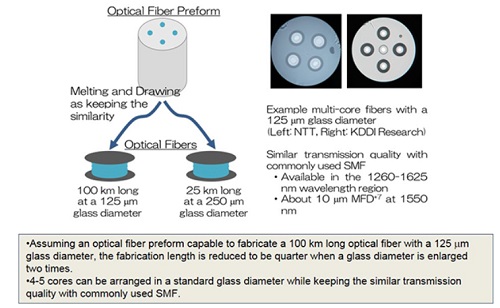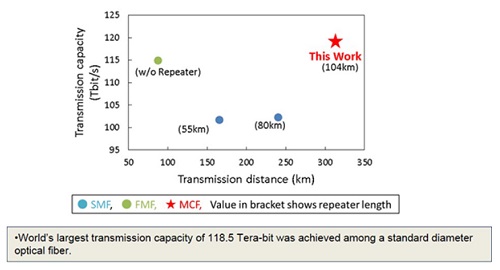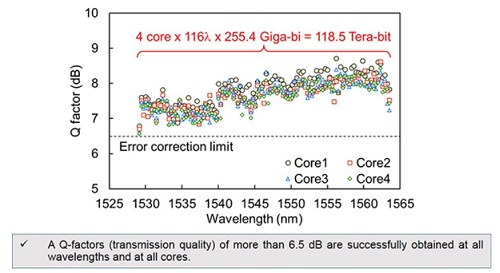|
|
|
|
|
|
| Accelerate Multi-Core Fiber Application using Current Standard Technology |
TOKYO, Aug 8, 2017 - (JCN Newswire) - Nippon Telegraph and Telephone Corporation, and six partners, KDDI Research, Inc., Sumitomo Electric Industries, Ltd., Fujikura Ltd., Furukawa Electric Co., Ltd., NEC Corporation, and Chiba Institute of Technology have demonstrated the world's largest transmission capacity of 118.5 Tera-bit/s(1) using a multi-core fiber with four optical paths (cores) in the same diameter of currently used optical fiber.
 | | Figure 1: Features of the proposed multi-core fiber |
 | | Figure 2: Schematic image of productivity reduction caused by a glass diameter enlargement, and example multi-core fibers with a standard glass diameter |
 | | Figure 3: Schematic image of multi-core transmission line composed of different vendors and its loss characteristics |
 | | Figure 4: Example of transmission experiments among a standard diameter optical fiber |
 | | Figure 5: Image of a cladding pump based multi-core optical amplifier and experimental result for power consumption reduction |
 | | Figure 6: Overview photos and optical connection image of MU-type (top) and SC-type (bottom) optical connectors. |
 | | Figure 7: Transmission performance of 16QAM based 116-wavelengths after a16-km transmission. |
A conventional glass diameter (125 micrometer)(2) in accordance with the international standard enables us to use existing optical fiber fabrication and optical connector technologies effectively. This achievement proves the concept of multi-core fiber based long-haul and large capacity transmission system consisting of multiple vendor technologies, and it makes significant progress on practical use of the multi-core fiber technology.
We will aim to introduce the standard diameter multi-core fiber by the early 2020s. We will also continue to contribute the realization of a future optical infrastructure which can support variety of data communication demands.
This remarkable achievement was reported in 4 August as a postdeadline paper(3) at the Opto Electronics and Communications Conference (OECC 2017), the largest conference on optical communication in Asia Pacific-Rim, which was held at Sands Expo and Convention Centre, Singapore.
This work was partially based on work commissioned by the National Institute of Information and Communications Technology (NICT).
http://www.acnnewswire.com/topimg/Low_NEC8817Fig1.jpg
Figure 1: Features of the proposed multi-core fiber
Research Background
World wide spread of various mobile terminal and data services continuously increases the transmission capacity more than 10% per year all over the world. This trend may cause capacity crunch in the currently used optical fiber by the late 2020s. Moreover, the expansion of optical fiber count and the convergence of optical wiring particularly in the data center and/or central office, which is caused by the world wide data capacity increase, would be serious problem.
With these as backgrounds, a multi-core fiber having multiple optical paths (cores) in one fiber has been investigated intensively all over the world in order to overcome the future capacity crunch and to realize the high density or space saving optical facilities. For example, ultra large capacity transmission experiments using a multi-core fiber with 10 cores or more have been demonstrated(4). However, these high core count multi-core fiber usually needs a thicker glass diameter, and it requires an extreme advance in the fabrication process and further development on sub-components. As a result, it is considered that 10 years or so would be necessary to make the high core count multi-core fiber practical.
In order to accelerate using the multi-core fiber technology, NTT, KDDI Research, Sumitomo Electric, Fujikura, Furukawa, NEC, and CIT developed a multi-core fiber with a conventional diameter in accordance with the current International standard. It enables to use existing optical fiber technology even though it limits the number of cores to 4-5.
Summary of Achievements
NTT, KDDI Research, Sumitomo Electric, Fujikura, Furukawa, NEC, and CIT:
- Clarified the design guideline for a multi-core fiber with conventional glass diameter in accordance with International standard,
- Realized a multi-core transmission line composed of a standard diameter multi-core fibers fabricated by multiple vendors,
- Proved a beyond 100 Tera-bit/s transmission using the standard diameter multi-core fiber transmission line.
These studies led to three major achievements:
- 4-5 cores can be arranged within a 125 micrometer glass diameter while maintaining the same transmission quality with the current optical fiber,
- A 316 km long multi-core transmission line is realized with a 0.21 dB/km average loss*5 concatenating the standard diameter multi-core fibers (4 cores) fabricated by multiple vendors randomly,
- World's largest transmission capacity of 118.5 Tera-bit/s is achieved among a standard diameter optical fiber using a multi-core transmission system composed of the above multi-core transmission line, multi-core optical amplifiers, and the existing optical connectors.
As a results, we successfully revealed the capacity extensionability and affinity with the existing technology of our multi-core fiber in accordance with the International standard of the current optical fiber.
Detail of Achievements
1.Design Guideline
During the fabrication process of an optical fiber, a relatively large size glass rod with a diameter of several to ten centimeters, namely preform, is prepared. An optical fiber is realized by melting and drawing the preform while keeping the geometrical similarity. When a glass diameter of an optical fiber is enlarged two times (e.g. from conventional 125 micrometer to 250 micrometer), the fabrication length obtained with the same size preform is reduced to a quarter. Therefore, the increase in the glass diameter directly affects the mass-productivity of an optical fiber. The current optical communication system is commonly using a single-mode fiber (SMF) with a core diameter of about 10 micrometer and it which can be used in all the telecommunication wavelength region (1260 nm - 1625 nm).
We then aim to realize a multi-core fiber with two features: i) having a glass and coating diameter of 125+/-0.7 micrometer and 235-265 micrometer in accordance with the International standard of the current optical fiber, ii) whose individual core can have the similar transmission quality with the commonly used SMF. In a multi-core fiber, the optical signal interference between neighboring cores(6) should be reduced sufficiently. NTT and KDDI Research revealed that 4-5 cores can be arranged in a 125 micrometer glass diameter.
http://www.acnnewswire.com/topimg/Low_NEC8817Fig2.jpg
Figure 2: Schematic image of productivity reduction caused by a glass diameter enlargement, and example multi-core fibers with a standard glass diameter
2. Multi-core transmission line composed of multiple vendor optical fibers
Based on the above design guideline, Sumitomo Electric, Fujikura, and Furukawa individually fabricated a multi-core fibers with four cores and more than 100 km length. All multi-core fibers can be used in the 1260 nm - 1625 nm wavelength region, and having the similar transmission property to the current SMF (cf. Mode filed diameter (MFD)(7) at 1550 nm is 9-10 micrometer).
The fabricated multi-core fibers were divided into a 20-40 km long pieces, and three transmission spans with a length of 104-107 km were re-constructed by splicing the multi-core fibers provided by different vendors intentionally. A satisfactory low loss features which is comparable to the conventional SMF was achieved. An average loss of four cores in each span was 0.22 dB/km or less including splicing losses. We spliced two multi-core fibers by melting each end, namely fusion splice technology. A 0.21 dB/km loss property was achieved as the average of all three spans.
These achievements indicate that our standard diameter multi-core fiber with similar transmission quality (MFD) with the conventional SMF enables us to greatly improve the productivity of the multi-core fiber made by the effective use of the existing fabrication technology and knowledge.
http://www.acnnewswire.com/topimg/Low_NEC8817Fig3.jpg
Figure 3: Schematic image of multi-core transmission line composed of different vendors and its loss characteristics
3. Beyond 100 Tera-bit transmission
A multi-core transmission system was constructed by concatenating three spans. Three multi-core optical amplifiers fabricated by NEC, KDDI Research, NTT, and Furukawa were inserted at each end of three spans in order to compensate the signal attenuation. Cladding pumping type multi-core optical amplifiers which is expected to reduce power consumption were used, and a 16% improvement was confirmed in this achievement(8). In order to confirm the capability of the constructed multi-core transmission line to beyond 100 Tera-bit/s transmission, 16QAM(9) based 116-wavelength signals were prepared and the output signal quality after 316 km long transmission were examined.
Fan-In/Fan-Out devices(10) fabricated by NTT and Furukawa were used to input/output signals to/from each core of multi-core fiber. Pluggable optical connectors(11) with existing MU-type or SC-type interfaces, fabricated by CIT and NTT, were used to connect the input/output end of the multi-core transmission lines and Fan-In/Fan-Out devices. These optical connectors have rotational alignment features in order to connect the facing four-cores correctly. Thus, the low loss and pluggable optical connection of multi-core structure was achieved.
Satisfactory well transmission quality was confirmed in all cores and all wavelengths, this result is the world's largest transmission capacity of 118.5 Tera-bit/s(12) among a standard diameter optical fiber. These achievements reveal that multi-core fiber with standard diameter can be used to realize an ultra large capacity transmission system overcoming the capacity crunch in the current SMF.
http://www.acnnewswire.com/topimg/Low_NEC8817Fig4.jpg
Figure 4: Example of transmission experiments among a standard diameter optical fiber
Future Prospects
The present achievement indicates that a multi-core fiber with the standard diameter can be used to realize a transmission capacity of more than 100 Tera-bit/s while enabling the productivity improvement and effective use of the existing technology. This achievement is expected to open up earlier practical use of the multi-core fiber technology.
We will aim to introduce the standard diameter multi-core fiber by the early 2020s. We will also continue to contribute the realization of a future optical infrastructure which can support variety of data communication demand.
(1) Tera-bit/s
Tera (Unit: T) corresponds to an amount of 1012. 100 Tera-bit transmission enables us to transfer 500 blue-ray disks (25 Giga-byte/disk) at one second.
(2) A glass diameter in accordance with International standard
In accordance with the International standard, a glass and a coating (including a glass and protection regions) diameters are specified at 125+/-0.7 micrometer and 235-265 micrometer, respectively in order to ensure an interconnection between optical fibers provided by different vendors.
(3) Postdeadline paper
A technical paper that is received after the regular submission deadline. In the optical communication research field, [research groups from around the world submit their best results. A limited number of papers that receive an extremely high evaluation in a selection meeting held during the conference period are accepted for presentation in the postdeadline session.
(4) Example achievements on multi-core fibers with 10-core or more
(5) Loss of optical fiber
A 0.21 dB/km contains loss at splicing points. We spliced two multi-core fibers by melting each end, namely fusion splice technology. A 0.21 dB/km loss is comparable property obtained with current optical fiber.
(6) Optical signal interference between neighboring cores
A small portion of an optical signal is transmitted outside the core. This causes interference between different optical signals and degrades the transmission quality when neighboring cores are too close to each other.
(7) Mode field diameter (MFD)
A parameter which shows a diameter of optical signal propagating in an optical fiber. MFD is an important parameter for ensuring the interconnection of optical fibers provided by different manufactures because larger difference in MFD results in the connection loss increase.
(8) Multi-core optical amplifier using cladding pumping
In a cladding pumping based multi-core optical amplifier, pumping light as an optical amplification source is injected into the cladding region which contains multiple cores. The other hand core pumping based multi-core optical amplifier uses multiple pumping light in order to launch the amplification source light into each core individually. The cladding pumping scheme is expected to reduce the power consumption compared with that in the core pumping scheme. In this achievement, a multi-core optical amplifier fabricated by NEC realized a 16% power reduction in which core and cladding pumping were well combined, so call a hybrid type multi-core optical amplifier.
http://www.acnnewswire.com/topimg/Low_NEC8817Fig5.jpg
Figure 5: Image of a cladding pump based multi-core optical amplifier and experimental result for power consumption reduction
(9) 16QAM signal
Traditional optical communication uses intensity modulation in which signals are sent using two distinct states ON and OFF to correspond to digital 0's and 1's. 16QAM (Quadrature amplitude modulation) signals are modulated by two independent optical signal components, namely I- and Q-components, using the 4-th level. This makes it possible to transfer 4x4 = 16 levels signals simultaneously.
(10) Fan-In/Fan-Out device
A device which enables to connect between four-individual conventional SMFs and four-cores in a multi-core fiber. In this achievement, both fiber- and waveguide-type devices were used.
(11) MU-type and SC-type optical connector
A pluggable optical connection technology which has been used in the current optical communication system. International standard has specified MU-, SC-, FC-types and so on based on the shape of connector.
http://www.acnnewswire.com/topimg/Low_NEC8817Fig6.jpg
Figure 6: Overview photos and optical connection image of MU-type (top) and SC-type (bottom) optical connectors.
(12) World's largest 118.5 Tera-bit transmission
In this achievement, 116-wavelengths with a 36 Giga-Baud (Giga corresponds to a 109), 16QAM (16-level = 24) modulation, and polarization multiplexed (2-orthogonal polarizations) were transmitted. A 12.75% bit were used for error correction, thus the effective transmission capacity becomes a 118.5 Tera-bit as shown below:
116-wavelengths x log216 x 2-polarizatoins x 4-core/1.1275 (error correction) = 118.5 Tera-bit.
http://www.acnnewswire.com/topimg/Low_NEC8817Fig7.jpg
Figure 7: Transmission performance of 16QAM based 116-wavelengths after a16-km transmission.
Contact:
NEC
Seiichiro Toda
s-toda@cj.jp.nec.com
+81-3-3798-6511
Topic: Press release summary
Source: NEC Corporation
Sectors: Telecoms, 5G, Wireless, Apps
https://www.acnnewswire.com
From the Asia Corporate News Network
Copyright © 2025 ACN Newswire. All rights reserved. A division of Asia Corporate News Network.
|
|
|
|

|
|
|
| |
| NEC Corporation Related News |
|
| Monday, 15 December 2025, 19:41 JST |
| NEC Provides Vehicle Management Equipment for Autonomous Driving at Tokyo International Airport |
|
| Monday, 15 December 2025, 19:04 JST |
| NEC and AEROTHAI Elevate Air Traffic Safety with Advanced Time Sync Solutions from Adtran Oscilloquartz |
|
| Friday, 12 December 2025, 19:59 JST |
| Bank Mandiri Enhances Digital Resiliency for Financial Trading in Indonesia through Advanced Time Sync Solutions with NEC and Adtran Oscilloquartz |
|
| Friday, 12 December 2025, 18:13 JST |
| NEC and ClimateAi sign a Memorandum of Understanding (MoU) for business co-creation to enhance climate resilience across various industries |
|
| Thursday, 11 December 2025, 19:00 JST |
| NEC Named to CDP's "A List" for Climate Change and Water Security for the Seventh Consecutive Year |
|
| More news >> |
|
|
|